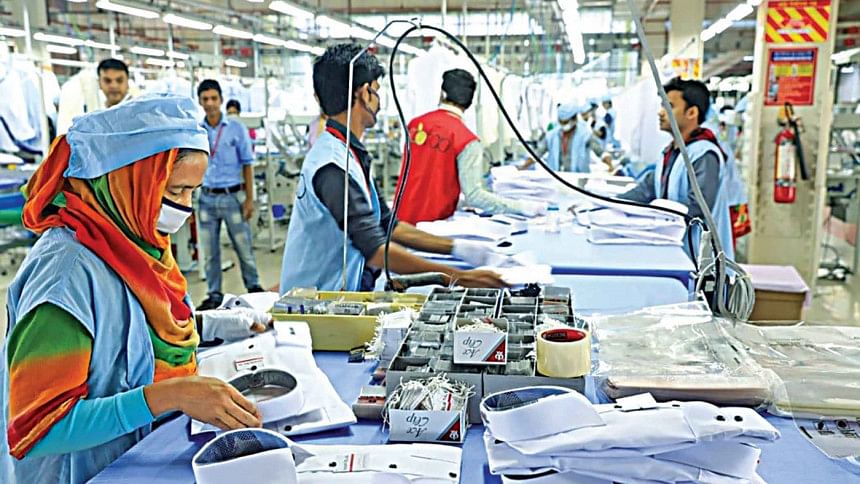Automation is inevitable, we must embrace it

When people write about automation, they often discuss it as if this is some futuristic development which will change the way we do business. Yet the way to see automation in my view, is something that is ongoing. In fact, the reality is that automation has been taking place at a global level for well over a century. Automation helps us do things quicker and smarter. It helps us operate more efficiently. It potentially helps us operate more sustainably. And it helps to make our businesses more profitable.
Automation does all these things, and much, much more.
So why, when we discuss automation in the context of Bangladesh's ready-made garment industry, do we often hear cries of concern? Why is there a reluctance or reticence to embrace automation wholeheartedly in our garment sector? Why are we still not taking a lead on this critical issue?

These and other questions will be addressed in this article. But first I'd like to offer some context about automation as a broader business topic.
The first point to make is that automation is here to stay. Recently, the World Economic Forum suggested that by the mid-2030s one-third of all jobs could be automated, based on research by consultants PwC. The World Economic Forum says the sector of the workforce most likely to be disrupted will be those people who have low educational attainment. This, in itself, is a strong argument for placing an increased focus on training and education alongside work in our RMG sector, and this is something our government has thankfully begun to look more closely at in recent years.
What about the issue of job losses? To address this head on, historical context is vital. I said at the start of this piece that automation has been an ongoing process for more than a century. Indeed, anxiety over job losses caused by the increased use of machinery has been around for more than 100 years. With each new technological development, concerns are raised about livelihoods or quality of life being changed irrevocably.
In the UK, the textile industry saw moves towards more automated ways of doing things as far back as the Industrial Revolution.
As the Industrial Revolution gathered pace, people moved from rural communities into larger, fast growing cities where they found work in textile mills and factories. Increasingly, workers and their unions watched with dismay as work that was once done by hand gave way to steam-powered machines which were driving unprecedented growth in output of items previously hand-crafted by artisan workers.
Some workers rioted, smashing machines and setting fire to business owners' homes. They feared job losses, but these lost jobs never materialised. Instead, automation facilitated increased economic growth which ultimately led to job creation. The fears about automation then were as misplaced as they are now.
McKinsey recently published a report in the wake of the impact of Covid-19 to support this sentiment. It pointed out that in recent years, all advanced economies have experienced major sectoral shifts in employment, first in agriculture and more recently in manufacturing.
Yet the point to note is that, throughout these large shifts of workers across occupations and sectors, overall employment as a share of the population has continued to grow. New industries and occupations have emerged to absorb workers displaced by technology.
Why has that happened? The reason is that, historically, new technologies and automation boost productivity growth, enabling companies to lower prices for consumers, pay higher wages, or distribute profits to shareholders. This in turn stimulates demand across the economy, boosting further job creation. Isn't that something we all want in Bangladesh?
In economics, it is well known that rising productivity is usually accompanied by employment growth. Using automation to boost productivity raises incomes, which are then spent, creating demand for goods and services across the economy.
Over the long term, history shows us that productivity growth enabled by automation has reduced the average hours worked per week and allowed people to enjoy more leisure time.

Across advanced economies, for instance, the length of the average workweek has fallen by nearly 50 percent since the early 1900s, reflecting shorter working hours, more paid days off for personal time and vacations, and the recent rise of part-time work.
Now let's come to Bangladesh and our own RMG industry. One of the most notable aspects of this industry is that it remains very people-intensive and provides millions of jobs for garment workers.
The industry has been a boon for our economy and there is no denying that it is a bona fide success story.
But the introduction of technology and automation has been fairly limited up to now. This has meant that, among other things, productivity rates have remained relatively low, certainly in comparison to some of our competitors. Low productivity rates mean wage rates remain low. Going back to the narrative above, as we have seen, higher productivity boosts profits, economic performance and standards of living. It's a virtuous circle, and one which Bangladesh now needs to be aspiring towards.
To put it bluntly, the Bangladesh RMG industry now needs to move onto the next level if it is to prosper and provide meaningful work. Moreover, if we fail to embrace automation in our industry, our very survival will be under threat, given that all of our major competitors—Vietnam, India, China and so on—are now looking to automation in a big way (although China, it has to be said, is ahead of the chasing pack).
So what do I mean by embracing automation? The key here is to think holistically. Automation ties in with embracing technology as well as upskilling our workforce via better education and training opportunities. These issues are all part of the same puzzle.
Thinking specifically about automation, it is already been widely used in parts of the textile industry, particularly in China, as I have mentioned. But the point to be made is that in the overwhelming majority of cases, automation and robots are only carrying out repetitive works. In these cases, automated technology is being harnessed to carry out extremely dull and mundane work which would ordinarily be done by the lowest skill/paid workers. Is it taking jobs? In some cases, jobs may disappear, but they will and are being replaced by higher skill jobs which can only be carried out by workers.
One example here is "sewbots"—short for sewing robots—a name used for automated sewing machines. This and similar technologies have been around for many years, and yet it is not like they have turned our industry upside down overnight. In addition, I have yet to hear a story of a "sewbot" leading to job losses. Instead, these and similar technologies are more likely to be used by a manufacturer to increase speed to market and factory efficiency and productivity. In other words, they are used to compliment and support an existing set up while also allowing people to focus on areas of activity where they can bring genuine added value.
Where else are robots and automation being used in our industry? The International Finance Corporation, the financial arm of the World Bank, has worked extensively in the textile industry, particularly around developing more sustainable supply chains.
According to its most recent research on the issue, published during 2020, automation in garment assembly is not progressing at the same pace as in other industries, with typically assembly activities such as sewing still very much the domain of human beings.
There are reasons why massive automation is not yet happening, and these include technical issues and cost concerns, particularly since it is tricky for manufacturers to forecast return on investment given the unpredictability of orders. These issues have, of course, been accentuated during the past nine months as the impact of the coronavirus pandemic has placed huge pressure on factory finances.
That said, the IFC suggests that segments of the manufacturing process, such as ginning, spinning, weaving and knitting have now been largely automated. Progressive factories are also introducing technologies such as 3D printing, laser cutting and laser stonewashing, resulting in fewer assembly line jobs but greater opportunities for skilled workers who will need to be trained and educated to operate next generation machinery, integrate telecommunications networks, service and repair sophisticated equipment and develop the programming languages that are the brain centres of modern factories.
In other words, automation sees some jobs disappear but new jobs spring up in adjacent, high value areas. Such progression is the hallmark of a successful economy.
Another key factor to consider in the automation debate is population growth. The world's population is expected to expand to an estimated nine billion people by 2030. In turn, the apparel industry is forecast to double in size to a USD 4.4 trillion business.

Some forecasters believe that, in the wake of this growth, new consumer markets will emerge with a focus on bespoke, individual apparel products produced at speed using 3D printing and associated infrastructure. The mass market will never disappear but a rising middle class with increased disposable income will likely see greater demand for high quality, individualised, responsibly produced apparel products. In many cases, consumers will want to know exactly how these products were made, using what materials, in what country and factory and the conditions in which they were made. Indeed, two of the most popular words in the fashion industry being used by brands and retailers right now are traceability and transparency.
All of the above requirements can only be satisfied by modern, progressive factories which blend a combination of sophisticated, automatized infrastructure with highly qualified and trained personnel. The automation and the skilled personnel go hand in hand and, as indicated, this brave new world will potentially lead to higher quality jobs in Bangladesh.
Another reason why Bangladesh must embrace automation is because the move towards more bespoke products which are fully transparent and traceable is something many brands are increasingly looking at. We even see some pundits suggest that this is an argument for near-shoring—the process whereby apparel production takes place closer to actual markets. The argument goes that to satisfy consumer demand for speed, precision and delivery, near-shoring will be on the rise moving forwards.
I personally have never bought this argument. Our industry has had the option of nearshoring for many decades. Indeed, it has been tried several times but with limited success due to a lack of local expertise, know-how and infrastructure.
Nonetheless, Bangladesh must remain alert to this issue and understand that, moving forwards, brands and retailers will be demanding a more sophisticated and compelling offering from sourcing hubs. As one of the world's leading garment manufacturers we must be ready to up our game: to produce faster and smarter and offer seamless packages, often using vertically integrated solutions (as China has so successfully embraced).
The only way we can do these things is by embracing automation. Automation and technology are the essential connective tissues, the invisible industrial lubricants that will enable our industry to boost its productivity and competitiveness on the global stage.
In summary, increase in automation and technology is an inevitable process all economies go through as they move from Lesser Developed Country (LDC) status. Bangladesh is at present the largest LDC in terms of population and economic size but it looks set to leave this category in the next few years.
To do so, it needs to continue its process of modernisation, embracing the digitised world and technological innovation to boost competitiveness while providing well paid, meaningful employment for its inhabitants.
Mostafiz Uddin is the Managing Director of Denim Expert Limited. He is also the Founder and CEO of Bangladesh Apparel Exchange (BAE).

 For all latest news, follow The Daily Star's Google News channel.
For all latest news, follow The Daily Star's Google News channel. 



Comments